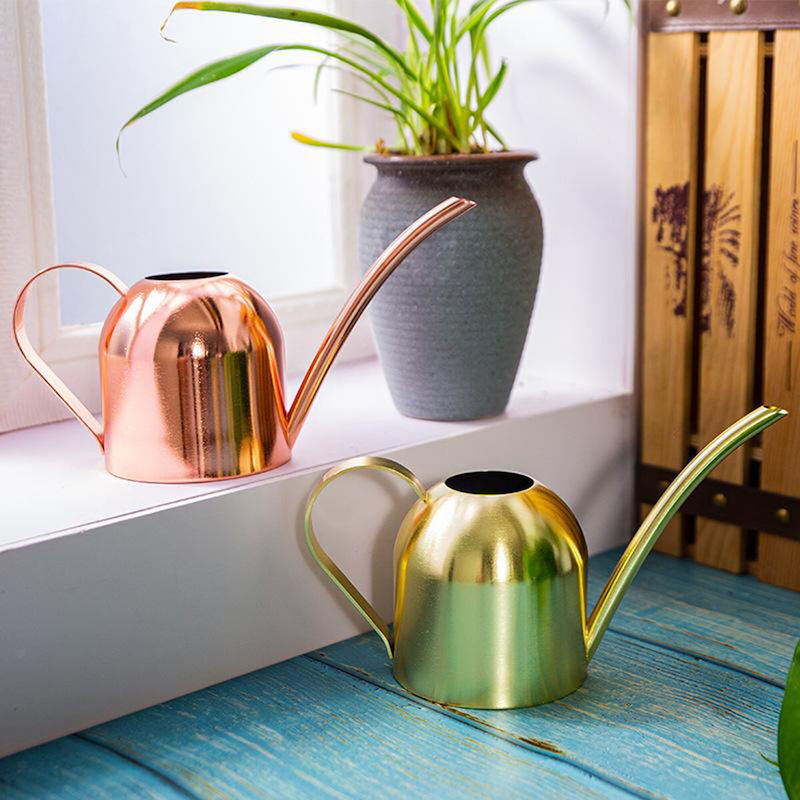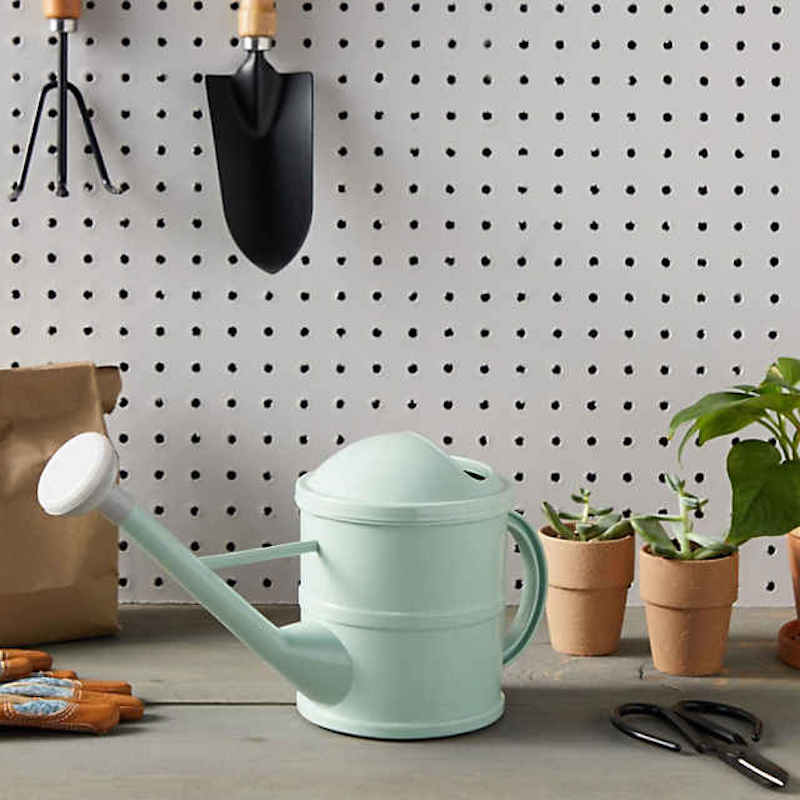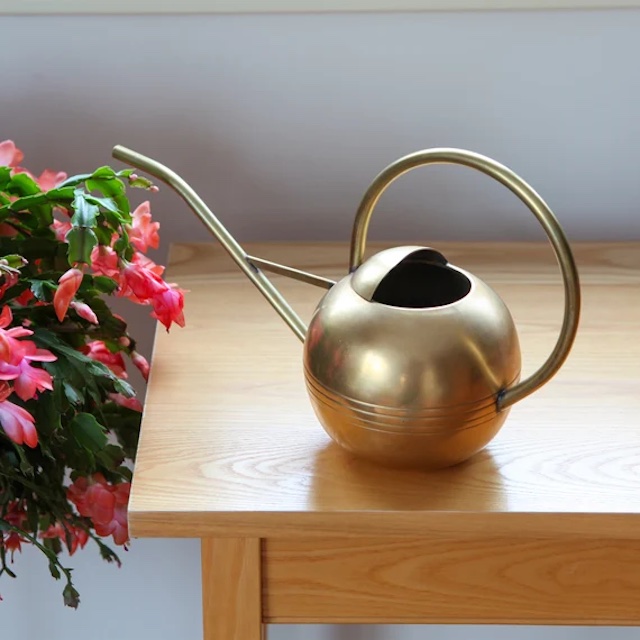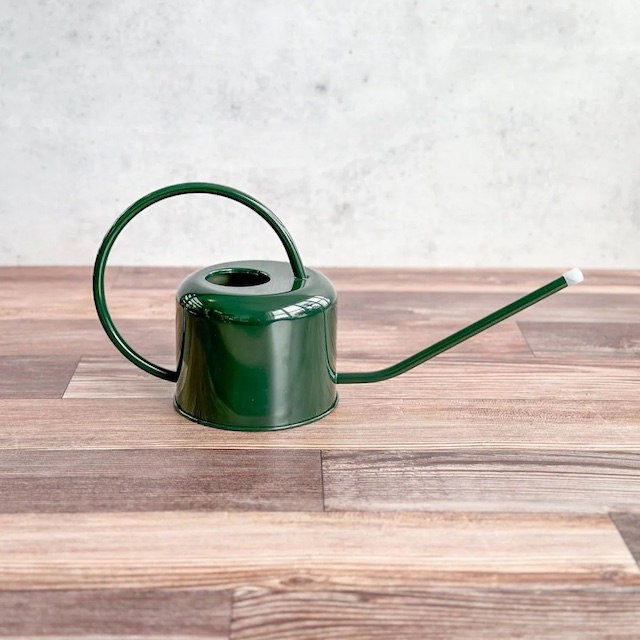
Mastering Plant Care Tips: Small Watering Can for Indoor Plants
Selecting the Right Small Watering Can for Your Indoor Plants
Choosing the right small watering can for your indoor plants is crucial. You need a can that fits your hand comfortably and reaches your plants with ease. Look for designs that complement your indoor space. A can with a long spout helps target water exactly where it’s needed. Consider the material too – plastic, metal, or ceramic are common. Each has its pros and cons. Plastic cans are lightweight and cheap, but may not last as long. Metal cans are durable, though they can be heavier. Ceramic cans look great, but they can be fragile and pricey. Pick a size that holds enough water for all your plants, without refilling too often. A smaller can prevent over-watering, a common mistake. Remember, a small watering can for indoor plants should be practical and fit your watering habits well.
Key Features to Look for in a Small Watering Can
When shopping for a small watering can for indoor plants, certain key features can make all the difference in ease of use and plant health. Here are the features to prioritize:
- Ergonomic Design: Choose a can with a comfortable grip that reduces hand strain. An ergonomic handle is essential for regular use.
- Long Spout: A long and narrow spout allows for precision watering, reaching the soil rather than the leaves which can help prevent diseases.
- Material Quality: Opt for materials that balance durability and weight. Metal is sturdy, while plastic is light. Pick based on your preference and the can’s longevity.
- Volume Capacity: Consider the amount of water it holds. It should be enough to water all your plants without the need for constant refills.
- Detachable Rose: Some cans come with a detachable rose (the sprinkling head), which is useful for gentle watering of delicate plants.
- Balance and Control: A well-balanced can gives better control over the water flow, preventing spills and over-watering.
- Aesthetic Appeal: While functionality is key, a can with a design that complements your living space adds to the indoor aesthetic.
Look for these features to ensure your small watering can is not only functional but also a joy to use for your indoor gardening tasks.
The Importance of Watering Frequency for Indoor Plants
Getting the watering frequency right is key to the health of indoor plants. Each plant has unique needs. Some thrive on moisture, while others need dry soil between watering. Finding the right balance is crucial. Too much water leads to root rot and pest issues. Too little, and your plants may wilt and lose vigor. Use a small watering can for indoor plants to control the amount of water. This prevents the common problem of over-watering. Check the soil moisture before watering. If it’s damp, wait. If dry, it’s time to water. Stick to a routine to ensure regular care. Pay attention to changing seasons as well. Plants often need less water in winter. Adjust your watering schedule to suit these cycles. In summary, a proper watering frequency keeps plants healthy and strong. It’s a simple yet vital part of indoor plant care.
Best Practices for Watering Indoor Plants with a Small Can
When watering indoor plants, some best practices can help ensure your plants receive the right amount of water without causing harm. Here are some tips to get you started:
- Check The Soil: Before watering, always check the soil’s moisture. Use your finger or a moisture meter.
- Water Evenly: Ensure the water covers all the soil surface, not just one side. This helps roots grow evenly.
- Use Room Temperature Water: Cold water can shock plant roots. Let tap water sit until it reaches room temperature.
- Morning Watering: Water plants in the morning. This gives them time to absorb water before nightfall.
- Avoid Wet Leaves: Direct water at the soil to prevent leaf diseases. A small can with a long spout is perfect for this.
- Drain Excess Water: After watering, let excess water drain away. Plants shouldn’t sit in water.
- Regular Cleaning: Keep your small watering can clean. Residue can clog the spout and introduce bacteria to your plants.
- Adapt to Seasons: Watering needs change with seasons. Plants typically need less water in cooler months.
By following these simple best practices when using a small watering can for indoor plants, you’ll promote healthier growth and avoid common watering pitfalls.
Maintaining Your Small Watering Can for Longevity
Caring for your small watering can for indoor plants is key to its longevity. Here’s how to do it:
- Regular Cleaning: Empty and rinse after each use. This prevents algae and mineral buildup.
- Proper Storage: Keep your can indoors to protect from weather. This prevents rust and damage.
- Inspect Regularly: Check for leaks or clogs. Fix issues promptly to maintain function.
- Gentle Use: Handle your can with care. Avoid dropping it, especially if it’s made of ceramic.
- Avoid Sunlight: Store out of direct sunlight. Sun can weaken plastic over time.
- Rust Prevention: For metal cans, dry after use. This keeps rust at bay.
Following these tips will help ensure your small watering can for indoor plants stands the test of time, making plant care a smoother process.
Common Mistakes to Avoid When Watering Indoor Plants
Using a small watering can for indoor plants is a smart choice. But even with the right can, common mistakes can harm your plants. To keep plants thriving, be aware of these errors:
- Overwatering: This is the most frequent mistake. Soil should feel dry before you water again. Overwatered plants fall prey to root rot.
- Ignoring Signs: Plants signal their needs. Drooping, yellowing, or dry leaves mean it’s time to reassess your watering routine.
- Using Cold Water: Cold water shocks roots. Always use water at room temperature to avoid this shock.
- Uneven Watering: Water should reach all parts of the soil. A long spout on your can helps with even distribution.
- Watering at Night: It’s best to water in the morning. Night watering can lead to fungal growth due to lower evaporation rates.
- Forgetting Seasonal Changes: Plants often need less water in cooler months. Adjust your watering habits with the seasons.
- Not Cleaning the Can: Leftover water and debris in the can can breed bacteria. Clean after use to keep things fresh.
Steer clear of these watering missteps to keep your indoor garden healthy. The right practices make all the difference.
Creative Ideas for DIY Small Watering Cans
Making your own small watering can for indoor plants can be fun and rewarding. Here are some creative DIY ideas:
- Recycled Containers: Turn old bottles or jugs into watering cans. Clean them, then poke holes in the lids for a sprinkling effect.
- Canned Good Transformation: Empty cans can work too. Clean a large can, nail holes in the bottom, and attach a handle.
- Milk Jug Makeover: A milk jug with a punctured cap makes a great large-capacity watering can. Add a handle for ease.
- Teapot Repurposing: An old teapot can be a quaint watering can. It’s perfect for delicate watering with its built-in spout.
- PVC Pipe Method: Construct a can from PVC pipes. Fit with a cap and drill holes for a custom sprinkle pattern.
- Squeeze Bottle Solution: A clean squeeze bottle, like a ketchup bottle, lets you control water flow easily. Just fill and use.
- Spray Bottle Watering: For fine mists, use a spray bottle. This is ideal for plants that prefer a gentle touch.
- Wooden Box Can: Craft a wooden box with a handle and a spout for a rustic look. Seal it properly to hold water.
Remember, when you make a DIY small watering can, ensure it’s easy to fill, carry, and pour. Always test it to make sure it works as expected before using it on your plants.
Tips for Eco-Friendly Watering Practices with Small Cans
Being eco-friendly is important for both the planet and your plants. When using a small watering can for indoor plants, you can adopt several green practices. Here are some tips to help you water your plants in a sustainable way:
- Reuse Water: Collect rainwater or reuse water from household tasks, like rinsing fruits and vegetables, to water your plants.
- Water Conservation: Only water your plants when necessary. Over-watering not only harms the plants but also wastes water. Checking the soil’s moisture can help you water only when required.
- Eco-Friendly Materials: Choose watering cans made from recycled materials or sustainable sources. This reduces your carbon footprint.
- Local Plants: Opt for plants that are native to your area. They usually require less water and are better adapted to the local climate.
- Mulching: Apply organic mulch to your plant’s soil. It helps retain moisture and reduces the need to water frequently.
- Drip Irrigation: For larger indoor plant collections, consider a drip irrigation system from a reused container to minimize water usage.
- Scheduled Watering: Stick to a watering schedule that aligns with the natural needs of your plants. This ensures you’re not giving more water than necessary.
By following these straightforward eco-friendly practices with your small watering can for indoor plants, you’re not only saving water but also ensuring the health of your beloved green companions.

Choosing the Perfect Small Watering Can for Indoor Plants
Overview of Small Watering Cans for Indoor Use
When tending to indoor plants, the right tools matter. A small watering can for indoor plants is vital for thorough, gentle watering. These cans come in various styles and sizes, tailored for the indoor gardener’s needs. They are designed for ease of use in limited spaces such as apartments or offices where large garden equipment would be impractical.
Efficient small watering cans reduce spillage and help target water flow to the plant’s base, not the leaves. This ensures the roots receive the moisture they need without wasting water. Comfortable handles and long spouts help reach plants with ease. Furthermore, these watering cans often boast aesthetic appeal, doubling as decor. They’re not just functional tools but part of the indoor landscape.
Utilizing a small watering can for indoor plants promotes healthy growth. It allows for precision in watering frequency and volume—a key factor in plant care. Remember, over-watering and under-watering can both harm your plant babies. Thus, a suitable small watering can is an investment in your indoor garden’s success and your plants’ longevity.
The Importance of Proper Watering for Indoor Plants
Proper watering is crucial for the health of indoor plants. Each plant has distinct moisture needs. Over-watering can lead to root rot, a common issue that harms or even kills plants. Conversely, under-watering stresses plants. They may wilt, drop leaves, or stop growing. Finding a balance is key.
A small watering can for indoor plants helps you control the water amount. It ensures you give just enough to keep the soil moist, not soggy. Most indoor plant species thrive in evenly moist soil. Hence, frequent light watering is often better than soaking the soil less often.
Using a small watering can also prevents water from splashing on the leaves. Wet foliage makes plants prone to fungal diseases. By directing the water straight to the soil, you promote root growth. This strengthens plants over time.
Moreover, proper watering with a small can keeps plants looking attractive. It helps maintain the aesthetic value of your indoor garden. Well-cared-for plants contribute to a pleasant indoor atmosphere. They can also improve air quality by increasing humidity levels.
In summary, using a small watering can for indoor plants ensures careful, precise watering. This contributes greatly to the health and beauty of your indoor garden. Remember, proper watering is as important as the right light, soil, and nutrients.
Factors to Consider When Choosing a Small Watering Can
Choosing the right small watering can for indoor plants is crucial. It’s not just about picking any can. You must consider a few factors to ensure you end up with the perfect one for your green friends. Here are key points to keep in mind:
- Size and Capacity: Think about how many plants you have and their water needs. A too-large can will be cumbersome, while a too-small one will mean more refilling trips.
- Material: Options include plastic, metal, and ceramic. Plastic is lightweight and affordable. Metal is durable and often has a classic look. Ceramic adds a decorative touch but can be heavy.
- Design and Comfort: Look for a can with an ergonomic handle. It should feel comfortable in your hand. Also, consider if you prefer a traditional design or a modern look.
- Spout Length and Design: A long spout can reach plants better and control the water flow. Some spouts have a detachable rose that distributes water evenly.
- Weight: Once filled, the can should still be easy to handle. Test the weight when buying, if possible, to avoid strain on your wrists.
- Ease of Filling: The opening should be wide enough to fill easily under most sinks. However, it should not be so wide that it causes spillage when pouring.
- Durability: You want a can that will last. Check reviews or ask for recommendations to find a reliable watering can.
- Price: Set a budget but remember, investing more in a quality product can save money in the long run.
- Aesthetic Preference: If you consider your watering can part of your decor, choose a style and color that match your space.
Reviewing these factors will help guide your decision when choosing a small watering can for indoor plants. With the right tool, watering becomes a simple, soothing routine benefiting both you and your plants.
Best Materials for Indoor Watering Cans
When selecting a small watering can for indoor plants, material choice is key. Each material offers benefits and potential drawbacks tailored to gardening needs. Here’s a quick guide to the best materials:
- Plastic: Plastic cans are lightweight and affordable, ideal for everyday use. They come in various colors and are resistant to rust. However, they may be less durable than other materials.
- Metal: Metal watering cans are sturdy and enduring; often providing a rustic or sophisticated look. They can be made of stainless steel or galvanized metal, which resist rusting. But, they might be heavier and more expensive than plastic.
- Ceramic: Ceramic offers an elegant, decorative option. These cans can double as a piece of art in your home. Despite their beauty, they are heavier and can break if dropped.
- Glass: While less common, glass watering cans add a contemporary flair. They allow you to see the water level, but they’re fragile and best used for delicate watering tasks.
In conclusion, the best material for a small watering can for indoor plants depends on your preferences for weight, durability, functionality, and design. Consider how often you’ll use the can, your budget, and whether you want it to complement your interior decor.
Top Features to Look For in a Small Watering Can
When searching for the perfect small watering can for indoor plants, you should consider several top features. These features will ensure ease of use and adequate care for your plants. Let’s explore what to look for:
- Adjustable Spout: A detachable or adjustable spout allows you to control the water flow. This is crucial for different plant needs.
- Ergonomic Handle: A well-designed handle reduces hand fatigue. Look for a handle that feels good to hold and balances well when the can is full.
- Water Level Indicator: If you have a translucent or clear watering can, a water level indicator is helpful. It shows how much water is left.
- Balance and Stability: A good watering can should not tip over easily. It should remain stable when you set it down, even when it’s full.
- Fine Rose Attachment: For delicate plants, a rose attachment that disperses water gently is a plus. It mimics soft rain and reduces impact on the soil.
- Easy to Clean: Your watering can should be simple to clean. Smooth, accessible surfaces help prevent mold or bacteria build-up.
- Fill Hole Size and Position: The fill hole should be big enough to pour water into without spilling. But it shouldn’t make pouring out difficult.
- Aesthetic Design: Many people like their watering cans to look good. Find one that fits your style and adds to your home decor.
By keeping these features in mind, you will find a small watering can that not only does the job but makes indoor gardening a more enjoyable activity.
Popular Brands and Models of Small Watering Cans
When it comes to finding the perfect small watering can for indoor plants, several brands stand out. They offer models that hit the mark in design, functionality, and durability. Here are a few popular choices:
- Haws: Known for high-quality, Haws offers beautiful metal and plastic cans. Many feature a long spout perfect for reaching plants. Their ergonomic designs make watering comfortable and precise.
- Ikea: Ikea’s watering cans are sleek and modern. They come in economical options, but don’t skimp on design or usability.
- Bosmere: Bosmere cans often include a detachable rose and are praised for balance and ease of pouring.
- Oxo: Oxo watering cans are best known for convenience. Their cans typically have a comfortable grip and are easy to fill and clean.
- Gardman: Gardman models bring both functionality and style. They offer metal cans that are durable and sometimes feature ornate designs.
- Bloem: For those who prefer plastic, Bloem provides lightweight and colorful options that resist rust and are easy to handle.
- Fiskars: Fiskars is well-regarded for a balance between form and function. Their cans may include spouts with adjustable flow for versatile watering.
Each of these brands has a variety of models to offer, ensuring you’ll find a small watering can that fits your indoor gardening needs perfectly.
Care and Maintenance Tips for Your Small Watering Can
Taking care of your small watering can is essential for its longevity. Here are simple tips to maintain it:
- Rinse After Use: Always rinse your can after watering. This helps prevent mineral buildup from the water.
- Dry Properly: Let your can air dry. Turn it upside down to avoid water collecting and causing rust or mold.
- Store Inside: If possible, keep your can indoors. This protects it from weather damage.
- Check for Leaks: Regularly check for leaks or cracks. Fix them early to avoid water waste.
- Clean Monthly: Give your can a thorough clean monthly. Use mild soap and warm water. Rinse well.
- Inspect Spouts and Roses: Look at spouts and roses for clogs. Clear them out to ensure even water flow.
- Handle with Care: Be gentle with your can, especially if it’s made of materials like ceramic or glass that can break easily.
- Avoid Chemicals: Don’t use harsh chemicals to clean your can. They can damage it over time.
- Refresh the Look: If your can is metal, you might need to paint it occasionally. This can prevent rust and keep it looking new.
With these care tips, your small watering can for indoor plants will remain a reliable tool for your gardening needs. Plus, it will continue to look great as part of your home decor.
DIY Small Watering Can Ideas for Plant Enthusiasts
For those who love a touch of personality and creativity in their plant care routine, DIY small watering cans are a fantastic project. Not only are they practical, but they also allow you to tailor the design to your aesthetic preferences and functionality needs. Here are some DIY ideas that plant enthusiasts can try:
- Recycled Containers: Turn an old plastic bottle into a small watering can. Simply poke holes in the cap for a makeshift rose and decorate the exterior.
- Painted Cans: Take a simple metal can and give it new life with waterproof paint. Choose colors and patterns that match your space.
- Decorative Elements: Glue on stones, shells, or beads to personalize your watering can. These elements add charm and texture.
- Upcycled Glass Bottles: Glass wine or liquor bottles make elegant watering cans. Fit them with spouts or drill holes in the cork for a delicate flow.
- Wooden Handles: Add a wooden handle to a metal can for a rustic look. It’s functional and brings a natural feel to your gardening tools.
- Fabric Wraps: Cover a plastic watering can with fabric for a chic, soft appearance. Use weather-resistant fabrics for durability.
- Chalkboard Labels: Stick a chalkboard label onto your can. Write plant names or watering schedules on it for organized care.
With these DIY small watering can ideas, you’ll have a functional and unique tool for your indoor garden. They’re perfect for making the task of watering your plants a little more special and personal.



